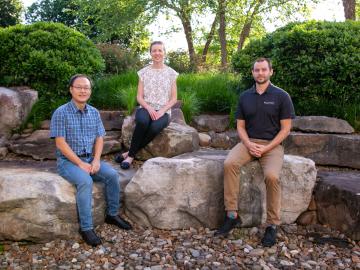
Filter News
Area of Research
- (-) Fuel Cycle Science and Technology (3)
- (-) Materials Characterization (2)
- (-) Neutron Science (190)
- (-) Supercomputing (311)
- Advanced Manufacturing (34)
- Biological Systems (18)
- Biology and Environment (177)
- Biology and Soft Matter (5)
- Building Technologies (12)
- Chemical and Engineering Materials (4)
- Chemistry and Physics at Interfaces (11)
- Clean Energy (522)
- Climate and Environmental Systems (14)
- Computational Biology (6)
- Computational Chemistry (5)
- Computational Engineering (5)
- Computer Science (19)
- Data (1)
- Earth Sciences (1)
- Electricity and Smart Grid (3)
- Energy Frontier Research Centers (14)
- Energy Sciences (5)
- Fossil Energy (3)
- Functional Materials for Energy (16)
- Fusion and Fission (54)
- Fusion Energy (17)
- Geographic Information Science and Technology (3)
- Isotope Development and Production (3)
- Isotopes (35)
- Materials (433)
- Materials for Computing (36)
- Materials Synthesis from Atoms to Systems (13)
- Materials Under Extremes (12)
- Mathematics (1)
- National Security (79)
- Neutron Data Analysis and Visualization (4)
- Nuclear Science and Technology (74)
- Nuclear Systems Modeling, Simulation and Validation (3)
- Nuclear Systems Technology (1)
- Quantum Condensed Matter (4)
- Quantum information Science (9)
- Reactor Technology (1)
- Renewable Energy (4)
- Sensors and Controls (5)
- Transportation Systems (11)
News Type
News Topics
- 3-D Printing/Advanced Manufacturing (10)
- Advanced Reactors (2)
- Artificial Intelligence (39)
- Big Data (20)
- Bioenergy (13)
- Biology (14)
- Biomedical (25)
- Biotechnology (2)
- Buildings (4)
- Chemical Sciences (6)
- Clean Water (2)
- Climate Change (17)
- Composites (1)
- Computer Science (98)
- Coronavirus (17)
- Critical Materials (3)
- Cybersecurity (9)
- Decarbonization (7)
- Energy Storage (14)
- Environment (28)
- Exascale Computing (22)
- Fossil Energy (1)
- Frontier (29)
- Fusion (2)
- Grid (5)
- High-Performance Computing (39)
- Isotopes (1)
- Machine Learning (16)
- Materials (30)
- Materials Science (34)
- Mathematics (1)
- Microscopy (8)
- Molten Salt (1)
- Nanotechnology (19)
- National Security (9)
- Net Zero (1)
- Neutron Science (101)
- Nuclear Energy (8)
- Partnerships (1)
- Physics (16)
- Polymers (3)
- Quantum Computing (19)
- Quantum Science (29)
- Security (6)
- Simulation (14)
- Software (1)
- Space Exploration (5)
- Summit (42)
- Sustainable Energy (11)
- Transportation (10)
Media Contacts

Five National Quantum Information Science Research Centers are leveraging the behavior of nature at the smallest scales to develop technologies for science’s most complex problems.

Researchers at the Department of Energy’s Oak Ridge National Laboratory and their technologies have received seven 2022 R&D 100 Awards, plus special recognition for a battery-related green technology product.

The U.S. Department of Energy’s Oak Ridge National Laboratory celebrated the debut of Frontier, the world’s fastest supercomputer and the dawn of the exascale computing era.

Travis Humble has been named director of the Quantum Science Center headquartered at ORNL. The QSC is a multi-institutional partnership that spans industry, academia and government institutions and is tasked with uncovering the full potential of quantum materials, sensors and algorithms.

Oak Ridge National Laboratory researchers are developing a first-of-its-kind artificial intelligence device for neutron scattering called Hyperspectral Computed Tomography, or HyperCT.

Scientists at ORNL used neutron scattering to determine whether a specific material’s atomic structure could host a novel state of matter called a spiral spin liquid.

To solve a long-standing puzzle about how long a neutron can “live” outside an atomic nucleus, physicists entertained a wild but testable theory positing the existence of a right-handed version of our left-handed universe.

Doug Kothe has been named associate laboratory director for the Computing and Computational Sciences Directorate at ORNL, effective June 6.

The Department of Energy’s Office of Science has selected three Oak Ridge National Laboratory scientists for Early Career Research Program awards.

To optimize biomaterials for reliable, cost-effective paper production, building construction, and biofuel development, researchers often study the structure of plant cells using techniques such as freezing plant samples or placing them in a vacuum.


